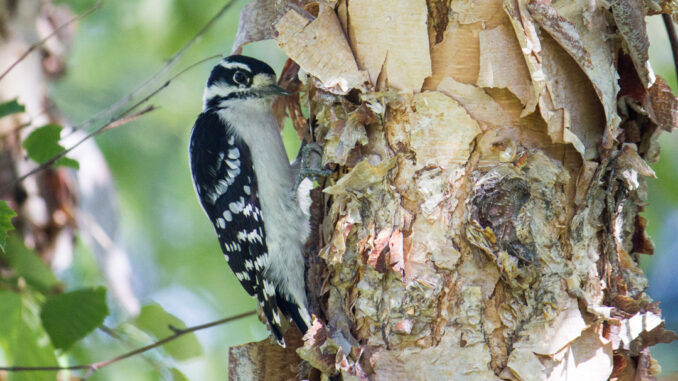
You might be in a warm climate while your garden is under snow; or at home and gazing out the window at the bare bones of winter trees. The ornamental features of a winter garden can deliver daily interest if the right trees are in place. And they will also invite the antics of charming, feathered visitors!
Winter trees
When we’re settling in for a long sequence of winter weeks, the garden is most often viewed through windows. With the absence of leaves and petals, the view focuses on the bare bones of the garden – bold tree structures and the charming winter birds attracted to their branches. While the landscape is covered with drifting snow and shrubs are bare, just one tree visible through a window is all that’s needed to draw attention and deliver pleasure.
What makes a perfect winter tree? It should be an appropriate size to fill the available space, without growing beyond the allowed parameters. It should be well tended with balanced form and appropriate pruning of dead wood. And, above all, it should be a beautiful structure with ornamental features on display in a long winter season.
Two trees with good garden ‘bones’ are the river birch and the Vanderwolf pyramid limber pine. These trees are beautiful in all seasons but are especially appreciated for their winter usefulness as garden features.
The Vanderwolf pine is part of the long-needled pine group, with soft clusters of long, deep-green needles, each with a slim silver stripe down the length. The needles have the same softness as familiar white pine, with smaller size and form well-suited to back or front yard landscapes. Vanderwolf pine grows slowly to a maximum of 25- to 30-feet high and 15- to 20-feet wide, with a neat pyramidal form and a small production of beautiful cone clusters at the top. (The cones are attractive for display in a bowl on a dining table or along a fireplace mantle.) Vanderwolf pine provides almost no shade and is a good choice for small gardens. The wood is unusually flexible, allowing branches to sway and bend gracefully in wind, and the full tree structure is sufficiently open to offer a see-through perspective in the garden. In late autumn, the Vanderwolf pine will sprinkle a soft carpet of needles that is non-acidic and useful to leave in place as mulch around the tree. The bark on young branches is dark brown and smooth, opening to a craggy and creased surface as the wood ages. Vanderwolf pine is an elegant and graceful tree in every season, but is especially attractive with freshly fallen snow on the long needle clusters.
The multi-trunk form of river birch is similar in every respect to classic white birch except that its curly exfoliating bark is tan, with fine twigs and slim branches carrying medium-green foliage in warmer seasons. After leaves turn gold in autumn, the curly bark becomes slightly pinkish in cold winter temperatures. River birch grows to 50-60 feet in height, with a crown width of 25-30 feet, and provides dappled shade in a sunny garden.
Vanderwolf pyramidal pine and river birch are both habitats for chickadees, nuthatches and woodpeckers. These charming birds will work hard at hiding nuts and seeds in the bark crevices of both trees. The essential factors are a bark with deep cracks and fissures, or an exfoliating bark that curls back and rolls itself into peels. If seeds are available from a feeder, you can expect a constant presence of these little birds in the winter garden. The best food for their needs is hulled sunflower seeds (no accumulation of seed shells on the ground) or black oil sunflower seeds still in their shells.
Cracked and peeling tree barks are primary receptacles for the larvae of summer insects, and you’ll often notice little winter birds searching the tree trunks for these tasty treats. They’ll eat whatever larva they find, and then insert their sunflower seeds for future meals. It’s fortunate that the two trees which these birds prefer are also attractive additions to northern gardens in any season.
No need to hurry home; the lawn can wait!
High on your ‘return home’ list could be getting the lawns up and growing as early as possible. Grass plants need to grow roots each spring to ensure viability through the full growing season. Before growing new spring blades, a lawn will first deepen its roots to ensure the ability to reach groundwater later in the summer when drought conditions may last for several weeks.
Many spring lawn fertilizer products contain high amounts of nitrogen to force quick growth of fresh green turf. But applying nitrogen fertilizer too early in the spring interferes with the lawn’s natural growth pattern. When summer weather begins to stress the lawn, the turf may thin out as individual grass plants have insufficient roots to cope with intense heat, drought and low moisture conditions. A healthy lawn with strong roots can become temporarily dormant, and then put up new green blades when environmental stress factors ease. But a lawn with insufficient roots will thin out permanently, as a percentage of grass plants are unable to sustain themselves.
The best plan is to allow the lawn to grow its spring roots in April and hold off on applying fertilizer until sometime in May. You’ll be following the natural schedule for lawn growth and ensuring an increasingly robust turf grass. You can be kind to your lawn with a second feeding of autumn fertilizer in September, knowing that you’ve provided the best year-round nutrition program for your turf grass.


